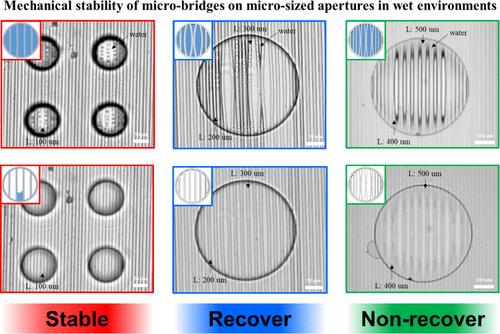微孔聚合物膜上毛细管力诱导的整体微桥聚类和恢复的设计规则
IF 3.7
2区 化学
Q2 CHEMISTRY, MULTIDISCIPLINARY
引用次数: 0
摘要
微桥结构已广泛应用于微机电系统。当带有微桥的设备在包括潮湿环境在内的各种环境中工作时,由于这种环境中液体的毛细力作用,会出现微/纳米结构溃缩、团聚和坍塌等结构故障。有必要制定全面的设计标准来解决这一问题。在此,我们研究了微孔上的微桥在潮湿条件下的结构稳定性。多尺度结构的微桥宽度为 10 μm,间距为 10 μm,高度为 6 μm,同时改变支撑微孔的尺寸。通过光学显微镜观察了微桥上的水分配和蒸发过程。结果发现,微桥在直径为 100 μm 的孔径上保持稳定,而在更大尺寸的孔径(300、500 μm)上则会出现团聚现象。有趣的是,与 500 μm 大小的孔径不同,300 μm 大小的孔径上的微桥群在完全蒸发水分后会逐渐恢复到原来的形态。为阐明这一现象,提出了毛细管力诱导聚类和恢复的简单理论模型,该模型与实验结果相吻合。按照该设计规则构建的微桥即使在潮湿条件下也能确保稳健、稳定地运行。这些发现有助于推动微/纳米工程的发展,并为开发创新型微器件提供了启示。本文章由计算机程序翻译,如有差异,请以英文原文为准。

Design Rules for Capillary Force-Induced Clustering and Recovery of Monolithic Microbridges on Microapertured Polymer Membrane
Microbridge structures have been widely used in microelectromechanical systems. When the devices with microbridges operate in diverse environments, including wet conditions, structural failures such as crumples, clustering, and collapse of micro/nanostructures occur due to the capillary force of liquid in this environment. It is necessary to establish comprehensive design criteria to address this. Herein, we investigate the structural stability of microbridges on microsized apertures in wet conditions. The multiscale structure is fabricated with microbridge width, spacing of 10 μm, and height of 6 μm while varying the supporting micro aperture size. The behavior of the microbridges is observed through an optical microscope during water dispensing on the bridges and evaporation. It is found that the microbridges remain stable on apertures of 100 μm in diameter, while clustering occurs on larger-sized apertures (300, 500 μm). Interestingly, in contrast to the 500 μm-sized aperture, the clustered microbridges on the 300 μm-sized aperture gradually recover to their original configuration after completely evaporating water. A simple theoretical model for capillary force-induced clustering and recovery is proposed to elucidate this phenomenon, which agrees with the experimental results. The microbridges constructed following the design rule can ensure robust and stable operation even in wet conditions. These findings contribute to advancing micro/nanoscale engineering and offer insights for developing innovative microdevices.
求助全文
通过发布文献求助,成功后即可免费获取论文全文。
去求助
来源期刊

Langmuir
化学-材料科学:综合
CiteScore
6.50
自引率
10.30%
发文量
1464
审稿时长
2.1 months
期刊介绍:
Langmuir is an interdisciplinary journal publishing articles in the following subject categories:
Colloids: surfactants and self-assembly, dispersions, emulsions, foams
Interfaces: adsorption, reactions, films, forces
Biological Interfaces: biocolloids, biomolecular and biomimetic materials
Materials: nano- and mesostructured materials, polymers, gels, liquid crystals
Electrochemistry: interfacial charge transfer, charge transport, electrocatalysis, electrokinetic phenomena, bioelectrochemistry
Devices and Applications: sensors, fluidics, patterning, catalysis, photonic crystals
However, when high-impact, original work is submitted that does not fit within the above categories, decisions to accept or decline such papers will be based on one criteria: What Would Irving Do?
Langmuir ranks #2 in citations out of 136 journals in the category of Physical Chemistry with 113,157 total citations. The journal received an Impact Factor of 4.384*.
This journal is also indexed in the categories of Materials Science (ranked #1) and Multidisciplinary Chemistry (ranked #5).
 求助内容:
求助内容: 应助结果提醒方式:
应助结果提醒方式:


